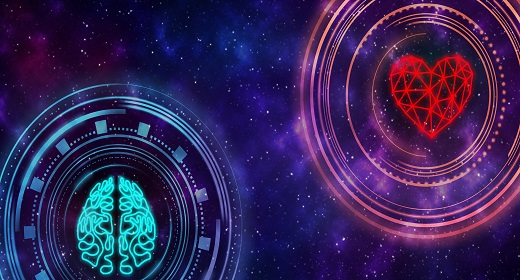“As more of humanity practices heart-based living, it will qualify the ‘rite’ of passage into the next level of consciousness….
Using our heart’s intuitive guidance, will become common sense — practical intelligence.”
We often hear ourselves or others say, “My mind thinks one thing, but my heart feels another.” Through many generations, we have heard and been told to listen to our heart when discerning the things that matter. As parents, many of us have advised our children to listen to or follow their heart when life’s meaningful decisions pop up. So, a lot of people feel the heart is a far more effective source of guidance than what our minds alone can offer us. HeartMath calls this the intuitive heart.
More and more people sense the heart is connected to a higher-capacity guidance system for creativity, clearer decisions and choices and especially for deeper, more caring relationships with others. Evidence for this is the many thousands of people in a variety of cultures who are benefitting from this deeper heart connection.
While science can help show us the way, science does not make the ultimate decisions on how we live our lives. We make those from within our intuitive hearts. Below, we share some of the science in research HeartMath Institute (HMI) has conducted to help explain the heart-intuition relationship and how this can benefit us mentally, emotionally, physically and spiritually.
Nonlocal Intuition Research
HeartMath researchers, and many others around the world, have conducted controlled and scientifically validated studies to determine how human intuition works. This research can help validate what we have believed for a very long time: The heart is the source of wisdom, higher intelligence and intuition.
A primary definition of intuition is the ability to understand or know something without conscious reasoning. Of the three types of intuition – implicit knowledge, energetic sensitivity and nonlocal intuition – HeartMath researchers decided to study nonlocal intuition. Nonlocal intuition cannot be explained by past or forgotten knowledge/implicit processes; or by sensing environmental signals/energetic sensitivity.
The Experiment
Several years ago Institute of Noetic Sciences senior scientist Dr. Dean Radin visited HeartMath’s research lab and shared the results of a study he conducted. In it, study participants’ autonomic nervous systems responded in advance of seeing randomly selected pictures intended to elicit a negative or calming emotional response. HeartMath wanted to replicate and expand the study.
HMI researchers added other protocols to its study, including measures of participants’ brain waves (EEG), their heart’s electrical activity (ECG) and their heart rate variability (HRV).
Twenty-six adults experienced in using HeartMath techniques and who could sustain a heart-coherent state completed two rounds of study protocols approximately two weeks apart. Half of the participants completed the protocols after they intentionally achieved a heart-coherent state for 10 minutes. The other half completed the same procedures without first achieving heart coherence. Then they reversed the process for the second round of monitoring, with the first group not becoming heart-coherent before completing the protocols and the second group becoming heart-coherent before. The point was to test whether heart coherence affected the results of the experiment.
Participants were told the study’s purpose was to test stress reactions and were unaware of its actual purpose. (This practice meets institutional-review-board standards.) Each participant sat at a computer and was instructed to click a mouse when ready to begin.
The screen stayed blank for six seconds. The participant’s physiological data was recorded by a special software program, and then, one by one, a series of 45 pictures was displayed on the screen. Each picture, displayed for 3 seconds, evoked either a strong emotional reaction or a calm state. After each picture, the screen went blank for 10 seconds. Participants repeated this process for all 45 pictures, 30 of which were known to evoke a calm response and 15 a strong emotional response.

The results were fascinating, showing that both the participants’ heart and brain appeared to indicate receiving and responding to information about the emotional quality of the pictures before the computer randomly selected them, as if they were responding to a future event. Specifically, these responses occurred, on average 4.8 seconds before the computer randomly selected pictures.
Even more profound, perhaps, was data showing the heart received information before the brain. “It is first registered from the heart,” Rollin McCraty Ph.D. explained, “then up to the brain (emotional and pre-frontal cortex), where we can logically relate what we are intuiting, then finally down to the gut (or where something stirs).”
Why this is important.
As David Straus, CEO of Reason Ventures, writes in Inc. Magazine, “The (aha moment) emanates from the heart and is fueled by its intuition. True visionary leadership develops inside the heart, not the brain. And it is there for each of us to grasp … we simply need the awareness of how to access it.”*
The results further appear to provide compelling evidence to suggest the physical heart is connected to a field of information not bound by the classical limits of time and space. Ancient mystics, philosophers and great thinkers had it right: The heart’s wisdom can help us discern our issues, communications and decisions more than we know. Becoming heart-coherent and practicing simple techniques can change everything by helping us access much more of our intuitive intelligence. Have we been seeking this intelligence through the centuries, and is it a portal to our higher capacities?










































